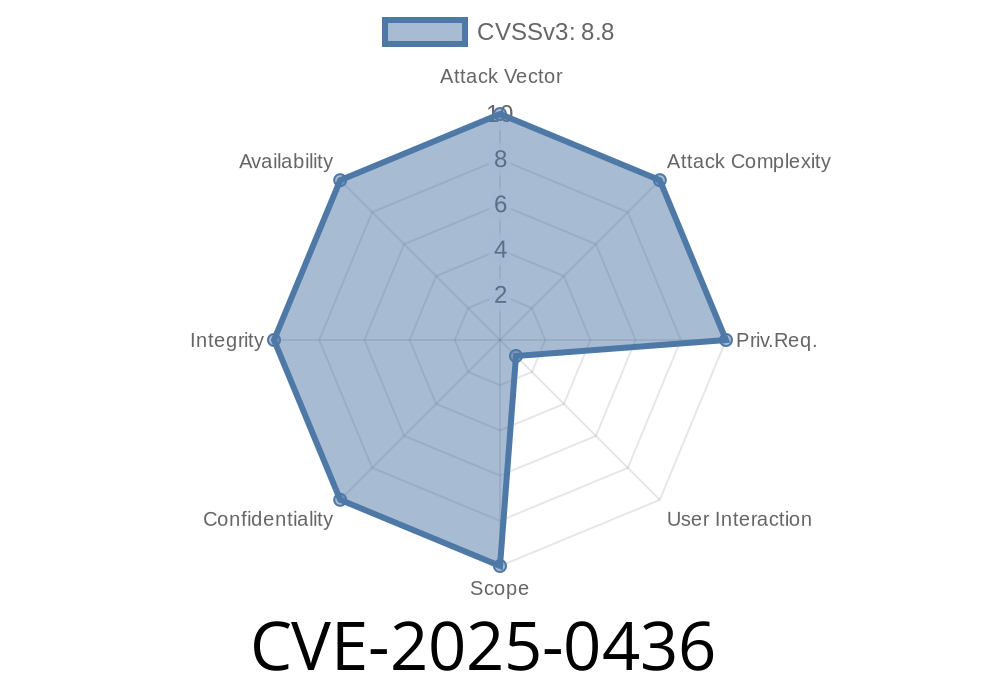The CVE-2025-0436 is a critical security vulnerability that was discovered in Google Chrome prior to version 132..6834.83. This vulnerability is a result of an integer overflow in Skia, a graphics library that Google's Chrome browser relies on for rendering graphics and text. As a consequence of the overflow, it opens the door for attackers to potentially exploit heap corruption via a malicious HTML page. According to Chromium's security metrics, this vulnerability has a severity rating of 'High,' meaning it poses a significant threat to users' security and privacy.
In this post, we'll be diving deeper into the specifics of this vulnerability. We'll cover what makes it tick and ways it can be exploited, while also providing relevant code snippets to illustrate the issue further. Additionally, we'll delve into the original references and reports that brought this vulnerability to light.
Understanding CVE-2025-0436
So, how does the CVE-2025-0436 vulnerability work? It all boils down to an integer overflow in Skia, the open-source graphics engine at the heart of Google Chrome. The overflow occurs due to the way the Skia engine handles certain data types and calculations in memory. Essentially, this vulnerability can be exploited by luring a user into visiting a crafted HTML page, leading to heap corruption, which in turn enables a remote attacker to execute arbitrary code on the target system.
To better understand the mechanics, let's look at a code snippet that demonstrates the integer overflow in Skia:
// Skia code snippet illustrating the integer overflow vulnerability
int32_t inputWidth = ...;
int32_t inputHeight = ...;
int64_t totalArea = static_cast<int64_t>(inputWidth) * inputHeight; // Potential integer overflow
if (totalArea > INT32_MAX) {
// Handle overflow error
}
In the above example, an input width and height are multiplied, resulting in a potential integer overflow. If the totalArea value exceeds that of INT32_MAX, the overflow occurs. This can set the stage for heap corruption.
The Chromium team initially reported and documented the vulnerability at the following locations
1. Chromium Security Issue: A detailed description of the vulnerability, potential implications, and the version of Google Chrome affected by it.
2. Skia.graphics: Official website for Skia, the open-source graphics library where the vulnerability resides.
A successful exploitation of the CVE-2025-0436 vulnerability would require a few things
1. Crafting a malicious HTML page: An attacker would need to create an HTML page that could trigger the integer overflow in Skia. This could include input values, images, or canvas elements that exceed specific size limits.
2. Getting the user to visit the page: The attacker would then have to find a way to lure the unsuspecting user into visiting the malicious page. This could be achieved through social engineering tactics, such as phishing emails or links embedded in other websites.
3. Exploiting the heap corruption: Once the integer overflow is triggered, and heap corruption occurs, the attacker could exploit this to execute arbitrary code on the victim's computer.
In Conclusion
The CVE-2025-0436 vulnerability, with its high risk rating, should serve as a wake-up call to Chrome users. Upgrading to Google Chrome 132..6834.83 or later is a must to avoid falling victim to any potential exploits. By maintaining an up-to-date browser and practicing safe browsing habits, Chrome users can reduce their risk of exposure to this, and many other security vulnerabilities.
Stay safe, and be sure to keep an eye on the latest security updates for your favorite browsers and devices. A proactive approach to cybersecurity can make all the difference in protecting your personal information and digital life.
Timeline
Published on: 01/15/2025 11:15:09 UTC
Last modified on: 01/15/2025 15:15:14 UTC
